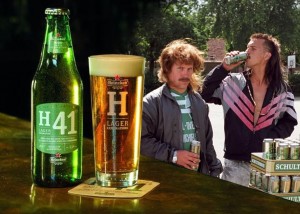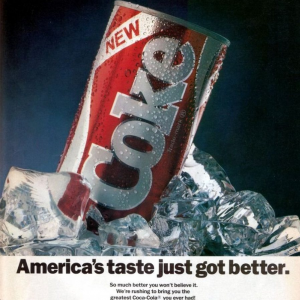Lager is doomed
 It has arrived: when I walked through the sunny historic centre of Utrecht this morning, my eye was caught by some big pub windows announcing the ‘Limited H41 Lager Explorations’. The new Heineken beer had reached my town. ‘Specially brewed with a rare yeast from Patagonia’. And all I could think of was: New Coke.
It has arrived: when I walked through the sunny historic centre of Utrecht this morning, my eye was caught by some big pub windows announcing the ‘Limited H41 Lager Explorations’. The new Heineken beer had reached my town. ‘Specially brewed with a rare yeast from Patagonia’. And all I could think of was: New Coke.
It’s a well-known story. In the USA in 1985 Coca-Cola, while still market leader, was facing more and more competition from Pepsi. With their ad campaigns featuring Michael Jackson, their taste tests that supposedly always found in favour of Pepsi, and especially their slogan ‘Choice of the next generation’ Pepsi was nibbling away more and more customers, especially young ones. Coca-Cola didn’t want to be outdone and with a lot of hoopla replaced its old cola by a renewed recipe: New Coke was born.
 Nationwide scorn followed. Costumers were well aware that Coca-Cola was making a painful capitulation to Pepsi. Angry customers demanded the return of the old recipe and flooded the company with petitions. Three months after the introduction of New Coke the old familiar cola returned to the supermarket shelves.[1]
Nationwide scorn followed. Costumers were well aware that Coca-Cola was making a painful capitulation to Pepsi. Angry customers demanded the return of the old recipe and flooded the company with petitions. Three months after the introduction of New Coke the old familiar cola returned to the supermarket shelves.[1]
What does all this have to do with Heineken? For one thing, it’s clear why they suddenly introduce this H41 and this Patagonia story (for the moment, only available in Holland and Italy, if I’m not mistaken). Before that, they came up with Heineken Extra Vers (‘Extra Fresh’): cooled, protected from light and delivered to the supermarket much quicker than regular Heineken. It has a fancy-pantsy paper wrapper around it, because the green bottles are letting through too much sunlight. They could have just kept the brown bottles Heineken was still using in Holland until recently, but no.
Why all this fooling around? Because lager is not doing well. Sure, it still is the most widely drunk beer type. In Holland, Heineken is the undisputed market leader, and worldwide they’re in second place. But lager consumption in the Netherlands has been decreasing for years, and is not unthinkable that things will get worse and worse.
This week, the excellent blog Zythophile by British journalist Martyn Cornell featured an interesting post about ‘Big Lager’. That’s his description of the same phenomenon: lager accounts for the lion’s share of beer consumed in Britain nowadays. But in the 19th century, ‘Big Porter’ was the most widely drunk beer, until over the course of that century it was replaced by ‘Big Mild’. Around 1960 bitter, also known as pale ale, suddenly became the most popular. Therefore, Cornell sees no reason why ‘Big Lager’, like its predecessors, couldn’t be pushed from the market by yet another beer.[2]
Why do beer types wither away? Cornell thinks it has a lot to do with the public image of a beer. Mild lost to bitter because it was a low-prestige beer: upper-class pubs would even advertise with ‘no mild ale sold’. For a while this was no problem, but in the 1950s lower-class labourers emancipated and suddenly mild was not good enough for them anymore: ‘Traditionally bitter is looked on as the bosses’ drink. Any man reckons today he’s as good as his boss. So he chooses bitter.’ And it’s a generation thing: the lager generation started drinking (legally) in the 1970s at the age of 18, but these drinkers now have grey hairs. Another 10 to 15 years and they’ll be in a retirement home or pushing up daisies. And that might just be the end of Big Lager, Cornell argues.
Or as his fellow beer history fan Ron Pattinson put it: ‘What tends to send beer styles on the path to extinction, is when they come associated with old people… and when styles start going out of fashion, it can happen incredibly quickly.’ This is what happened in England to porter, to mild, and it won’t stop there.[3]
Back to the Netherlands, after all a country that has a record when it comes to making beer types disappear. What is lager here today? Slowly it starts to become a beer for old farts with beer bellies. For anti-social idiots driving around on motor scooters and in Opel Mantas, like the Schultenbräu-drinking protagonists of the Dutch tv show New Kids. Sure, I drink lager too sometimes, but mostly on festivals or on King’s Day. The only quality of lager nowadays seems to be that you can swallow big amounts of it, without paying attention to what it is you’re drinking.
Which is fine, but more and more I wonder why lager factories like Heineken are still pretending to make a ‘premium’ product. I don’t have a problem with Heineken as a company: if Gerard Adriaan Heineken hadn’t bought the small Hooiberg brewery in 1864, perhaps Holland would have not been a beer drinking nation to begin with, and with their Heineken Collection, at least they are a big Dutch brewery that takes its own history seriously. But their H41 is a sign of weakness.
 If you look at old Dutch price lists, you’ll see that pilsener lager once really was a ‘premium’ beer: in Holland, pilsener was by far the most expensive beer type, only outdone the heavier and medicine-like stout. Pilsener could be twice as expensive as simple ‘gerste’ or ‘gerste lager’ beer! Unfortunately, this was followed by hundred years of cutting costs. Once pils had pushed all other beer types off the Dutch market because of its good name, the various brewers started adding more and more corn, rice and maltose. The taste got plainer and plainer, until one fine day cans of dirt-cheap lager were awaiting their homeless customers in every Aldi supermarket across the country.
If you look at old Dutch price lists, you’ll see that pilsener lager once really was a ‘premium’ beer: in Holland, pilsener was by far the most expensive beer type, only outdone the heavier and medicine-like stout. Pilsener could be twice as expensive as simple ‘gerste’ or ‘gerste lager’ beer! Unfortunately, this was followed by hundred years of cutting costs. Once pils had pushed all other beer types off the Dutch market because of its good name, the various brewers started adding more and more corn, rice and maltose. The taste got plainer and plainer, until one fine day cans of dirt-cheap lager were awaiting their homeless customers in every Aldi supermarket across the country.
My point is, the first hamburgers McDonald’s made in 1940 probably were sublime. The best burgers ever. But once you’ve got a good reputation clients will come anyway, and you can start replacing everything that was good about the product by everything that is cheap. The product is not leading anymore, marketing is.
Which brings us back to H41. Patagonia? Everything around this beer oozes marketing stunt. Dutch beer blogger Rick Kempen had to book a €49 VIP tour through the Heineken Experience in Amsterdam to be one of the first people to taste it. ‘Its maltiness was overwhelming… spiciness and fruit tones like a blonde abbey beer… the fullness of taste persisted… at a certain moment, I could swear I discovered hints of lemongrass…’[4] I’m afraid Rick has slightly fallen victim to the Westvleteren effect: if it’s expensive and rare, it must be good. In reality, the average specialty beer drinker’s expectations at hearing the brand name Heineken are lower than ever.
Lager is doomed, and H41 is not going to help. Of course, the big lager factories have been buying smaller breweries and brands. For years Heineken has been the puppet master behind beers like Affligem, Wieckse Witte, Murphy’s and Desperados. The big breweries will have no problem surviving. But the days that father settled comfortably on the couch in front of the telly, to watch Match of the Day with a well-deserved bottle of lager in his hands, are over. Today’s young dads are watching Netflix drinking an IPA or a saison. And not necessarily one made by a big brewer.
When I visited a Dutch sports event last week (the Giro d’Italia started off in Holland, don’t ask why) I had to buy frigging tokens to be able to queue for a €2,50 plastic glass of lukewarm Grolsch. A bit further along the road, a local brewer had a stand where for 50 eurocent less I could purchase a delicious freshly brewed IPA. If things have come this far, even in a boring Dutch town like Apeldoorn where this isn’t even the only brewer, then in the long run the Big Lager guys are facing a problem. Just so you know.[5]
[1] Compare http://time.com/3822869/new-coke-history/.
[2] http://zythophile.co.uk/2016/05/08/will-big-lager-one-day-go-the-same-way-as-big-porter/.
[3] http://heritageradionetwork.org/podcast/beer-sessions-radio-episode-206-beer-history-with-ron-pattinson/.
[4] http://www.mylifewithbeer.nl/heineken-experimenteert-met-de-ziel-van-het-bier/.
[5] This article was based on an earlier version in Dutch, http://verlorenbieren.nl/pils-is-ten-dode-opgeschreven/.






Leave a Reply